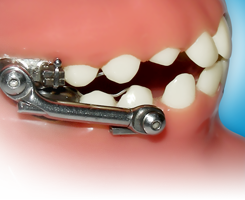Metal Braces
 Metal braces are the most common type of braces. They are made of high-grade stainless steel. Today's metal braces are smaller, more comfortable and more attractive.
Metal braces are the most common type of braces. They are made of high-grade stainless steel. Today's metal braces are smaller, more comfortable and more attractive.
Ceramic Braces
 Ceramic braces are made of translucent (clear) material. They are most popular with adult patients, due to their cosmetic appeal. The only drawback to ceramic brackets are that they are more fragile, and the elastic ties can discolor between orthodontic visits.
Ceramic braces are made of translucent (clear) material. They are most popular with adult patients, due to their cosmetic appeal. The only drawback to ceramic brackets are that they are more fragile, and the elastic ties can discolor between orthodontic visits.
Invisalign®

The Invisalign® System is a series of clear overlay templates, called aligners, that have been generated by computer simulation to gradually move the teeth. This system is available to adult and adolescent patients for certain orthodontic corrections.
Ask us if you are a candidate for the Invisalign® system.
Palatal Expander Device (PED)

Attached to the upper molars through bonding or by cemented bands, the Palatal Expander Device is an orthodontic device used to create wider space in the upper jaw. It is typically used when the upper jaw is too narrow for the lower jaw, or when the upper teeth are crowded or blocked out of the dental arch. (CLICK PHOTO TO ENLARGE)
Palatal expanders create more space in a child's mouth by gradually widening the upper jaw. Although this may sound scary, it's really quite easy — both to do and to tolerate. That's because the upper jaw actually develops as two separate halves that don't completely fuse together until sometime after puberty. Before that happens, the two bones can gently be separated and stabilized over a period of several months.
What to Expect
There can be some soreness or a feeling of pressure for a few minutes after the key is turned, but activating an expander actually causes less discomfort than having braces tightened. Your child may find that speaking and eating feels different at first as the tongue adjusts to the presence of the appliance. It is also completely normal to see a gap develop between the front teeth. This shows that the expander is having the desired effect. When all is said and done, your child's permanent teeth will be beautifully aligned with neither too much nor too little space between them.
Herbst
 One of the most common problems orthodontics treat is the discrepancy that occurs when the upper teeth protrude beyond the lower. Ordinarily, when we see a patient with the upper teeth protruding, we tend to think that the upper jaw and teeth are too far forward; but, more often than not, this condition is due to a small lower jaw that is further back than it should be. With these patients, we would like to encourage the lower jaw to catch up in growth, and braces like the Herbst appliance help this happen.
One of the most common problems orthodontics treat is the discrepancy that occurs when the upper teeth protrude beyond the lower. Ordinarily, when we see a patient with the upper teeth protruding, we tend to think that the upper jaw and teeth are too far forward; but, more often than not, this condition is due to a small lower jaw that is further back than it should be. With these patients, we would like to encourage the lower jaw to catch up in growth, and braces like the Herbst appliance help this happen.
Even though the Herbst appliance prevents the lower jaw from moving backward, opening and closing movement still occur easily, and patients do not have any problems learning to chew their food with their lower jaw in this new position.
As with all kinds of braces, patients with Herbst appliances need to be careful about what they eat. For instance, cold foods such as ice slushes, Popsicles and ice will freeze the cement and make the brace loosen. Sticky foods such as caramels, bubble gum and candy suckers will pull the brace away from the teeth. Hard foods like crisp vegetables and hard candies will bend and loosen the Herbst appliance, too. So stay away from these foods during your orthodontic treatment.
Your Herbst appliance will be checked and adjusted at your appointments. If, sometime between appointments, you develop some sore areas on the inside of your cheeks, please do not try to adjust the appliance yourself. Call for an appointment so that the necessary adjustments can be made.
Wearing a Herbst Appliance
At first, your mouth will feel unusually full and speaking will be awkward. But if you practice reading aloud, your ordinary speech will return quickly. You may also notice more saliva than normal, but this will decrease as you become accustomed to the appliance.
Brace Color Chooser